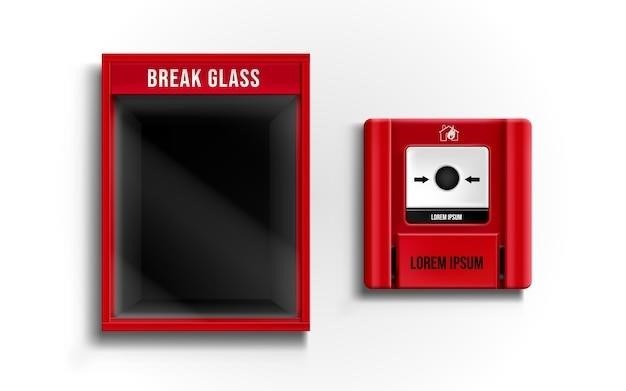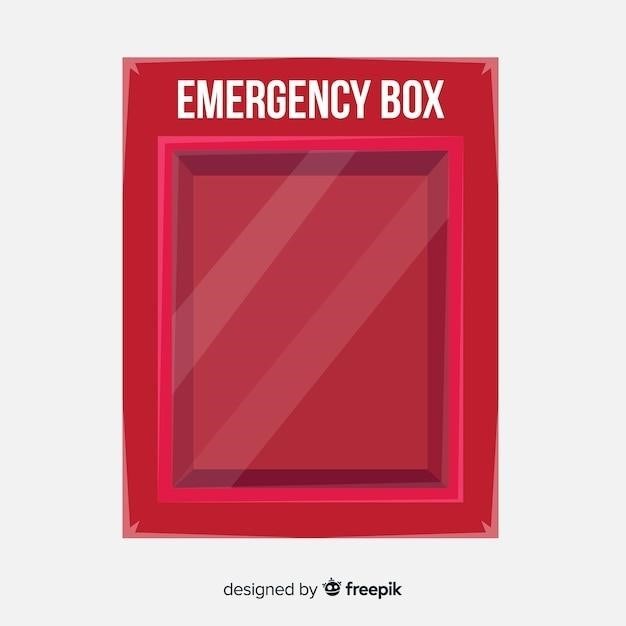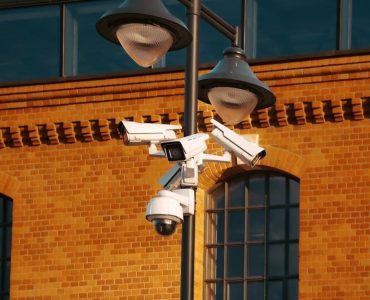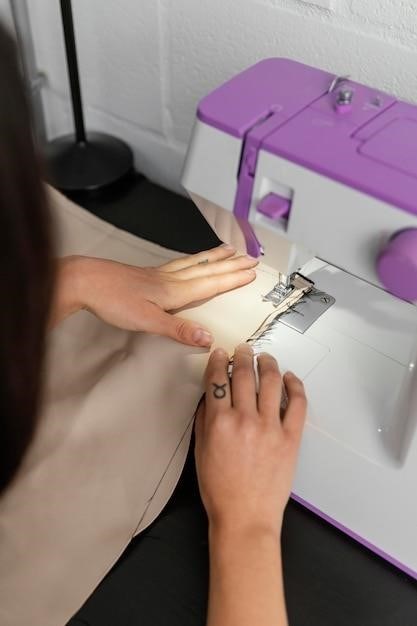Manual Fire Alarm Box Installation⁚ A Comprehensive Guide

This guide provides a step-by-step approach to installing manual fire alarm boxes, ensuring compliance with NFPA 72 and other relevant codes. Proper placement, mounting height, wiring, and connection to the control panel are crucial for reliable fire alarm system functionality. Regular testing and maintenance are essential for optimal performance and safety.
Placement and Spacing Requirements
Strategic placement of manual fire alarm boxes is paramount for effective emergency response. NFPA 72 and local fire codes dictate specific guidelines to ensure accessibility and coverage. Boxes should be located along primary escape routes, within easy reach of occupants, and ideally, no more than 200 feet (61 meters) apart, measured horizontally. Consider the building’s layout and occupancy to determine optimal placement. Placement near exits is crucial, generally within 5 feet (1.52 meters) of each exit entrance on every floor. However, placement should avoid areas prone to obstruction or damage, like those subject to heavy foot traffic or potential vandalism. Furthermore, consider factors like visual clarity and ease of access for people with disabilities. Always consult local building codes and fire safety regulations for specific requirements before installation. Improper placement can compromise the effectiveness of the entire fire alarm system, potentially leading to delayed response times during emergencies.
Mounting Height and Accessibility
The mounting height of a manual fire alarm box is a critical aspect of its effectiveness and accessibility. NFPA 72 recommends a standard height range of 42 to 48 inches (1.07 to 1.22 meters) above the finished floor. This range ensures that the pull station is easily reachable by most adults while remaining out of the reach of children who might accidentally trigger a false alarm. However, local building codes may specify alternative height requirements depending on the specific building type and occupancy. When determining the optimal height, consider the needs of all potential users, including those with disabilities. The pull station should be easily visible and accessible from a typical vantage point within the space. Obstructions such as furniture, signs, or equipment should be avoided. Accessibility for wheelchair users requires careful consideration; the box must be positioned to allow comfortable and convenient operation for individuals using wheelchairs. Clear signage indicating the location of the pull station can further enhance accessibility, particularly in areas with limited visibility.

Electrical Box Installation and Wiring
Before installing the manual fire alarm box, ensure the electrical box is correctly positioned and securely mounted. The box should be appropriately sized for the chosen pull station and any associated wiring. Use a standard single-gang, double-gang, or 4-inch square electrical box, depending on the specific requirements. For surface mounting, ensure the box is firmly attached to the wall using appropriate screws and anchors. For semi-flush mounting, carefully cut the wall opening to accommodate the box and ensure a snug fit. Proper grounding is crucial for safety and reliable system operation. Connect the ground wire from the electrical box to the building’s grounding system, following all relevant electrical codes. The wiring to the manual fire alarm box must use appropriately sized and rated fire alarm cable, typically a low-voltage, shielded cable designed for fire alarm applications. Never use household wiring for this purpose. All wiring connections should be made carefully and securely within the electrical box, ensuring no loose wires or potential short circuits. After wiring, carefully tuck the wires into the box, and use appropriate connectors for the connections. Before closing the box, check all connections one more time to ensure the wiring is correct and secure. Consult the manufacturer’s instructions for specific wiring diagrams and connection procedures.
Connecting to the Fire Alarm Control Panel
Connecting the manual fire alarm box to the fire alarm control panel is a critical step that requires careful attention to detail. This connection establishes the communication pathway between the pull station and the central monitoring system. Begin by identifying the appropriate terminals on the control panel for the manual fire alarm box circuit. Consult the control panel’s wiring diagram to determine the correct connections. Use the appropriately sized and rated fire alarm cable to connect the manual fire alarm box to the control panel. Ensure that the cable is properly routed and protected from damage along its path. Securely connect the wires to the corresponding terminals on both the manual fire alarm box and the control panel. Be mindful of polarity, as incorrect polarity can lead to system malfunctions. After making all connections, carefully inspect the wiring to ensure that all connections are tight and secure. Loose connections can create unreliable operation and potential hazards. Once the wiring is complete, carefully close the electrical box of the manual fire alarm box and the control panel enclosure. After the connections are made, test the system functionality. Activate the manual fire alarm box to verify the signal is properly transmitted to the control panel and initiates the desired alarm response. This ensures the proper integration of the manual fire alarm box into the overall fire alarm system. Document all connections and testing procedures for future reference and maintenance.
Types of Manual Fire Alarm Boxes and Their Features
Manual fire alarm boxes come in various types, each with unique features catering to different needs and environments. A common type is the standard surface-mount pull station, easily installed on walls near exits. These typically feature a bright red casing and a clearly visible pull lever for immediate activation. Some models incorporate tamper-resistant designs to prevent unauthorized activation. For aesthetic integration, flush-mount boxes are available, seamlessly blending into walls. These require a specialized electrical box for recessed installation. For specific applications, there are weatherproof boxes designed for outdoor use or harsh environments. They often include additional sealing and protective components to withstand rain, snow, or extreme temperatures. Furthermore, some manual fire alarm boxes incorporate features such as auxiliary contacts, providing additional signaling capabilities. These extra contacts can be used to trigger other systems or equipment during an alarm event. The choice of manual fire alarm box depends on factors such as building design, environmental conditions, and specific system requirements. Consult relevant building codes and standards to select an appropriate model for your application, ensuring compliance and effective emergency response.
Testing and Maintenance Procedures
Regular testing and maintenance of manual fire alarm boxes are crucial for ensuring their reliable operation during emergencies. NFPA 72 mandates annual testing, typically encompassing a visual inspection for damage or tampering, followed by a functional test to verify the alarm signal transmission to the control panel. This involves actuating the pull station and confirming the alarm’s proper activation and indication on the panel. The visual inspection should check for any signs of damage, corrosion, or loose connections, addressing any issues immediately. Testing procedures may vary slightly depending on the specific model and system, so always refer to the manufacturer’s instructions for detailed guidance. Beyond annual testing, periodic inspections are recommended to identify and rectify any potential problems before they escalate. This proactive approach ensures that the manual fire alarm boxes remain in optimal working condition, ready to perform their life-saving function when needed. Documentation of all testing and maintenance activities is essential for compliance and accountability. A detailed log, including test dates, results, and any corrective actions taken, helps maintain a comprehensive record of the system’s operational history.
Compliance with NFPA 72 and Other Codes
Adhering to NFPA 72 (National Fire Protection Association Standard for National Fire Alarm and Signaling Systems) and other relevant building codes is paramount during manual fire alarm box installation. NFPA 72 dictates precise requirements for placement, spacing, mounting height, and accessibility of manual pull stations, ensuring they are readily available to occupants in case of a fire emergency. These regulations specify maximum travel distances to the nearest alarm box, often 200 feet (61 meters) horizontally on the same floor. The standard also addresses the use of protective covers to prevent malicious or accidental activations, promoting the integrity and reliability of the system. Local building codes may impose additional stipulations, so consulting your local authority having jurisdiction (AHJ) is crucial before commencing installation. Compliance includes using listed and approved equipment, ensuring all components meet the required safety standards and performance criteria. Proper documentation of the installation, including inspection reports, testing results, and compliance certifications, is necessary to demonstrate adherence to the codes. Ignoring these regulations can lead to penalties, fines, and, most importantly, compromise the safety and effectiveness of the fire alarm system, potentially leading to hazardous situations.
Protective Covers and Preventing False Alarms
Preventing false alarms is critical for maintaining the reliability and effectiveness of a fire alarm system. One key strategy is the use of protective covers for manual fire alarm boxes. These covers, often made of durable, tamper-resistant materials, shield the pull station from accidental or intentional activation. Malicious false alarms can disrupt emergency response, create unnecessary costs, and desensitize occupants to genuine alarms. NFPA 72 often allows or requires the use of protective covers, especially in areas prone to vandalism or accidental triggering. The choice of cover depends on the environment; some are designed for specific applications, like high-traffic areas or outdoor installations. Proper installation of the protective cover is essential; it should be securely fastened while still permitting easy access in an emergency. Regular inspection of the covers for damage or tampering is vital, ensuring their continued effectiveness. In addition to protective covers, educating occupants about the proper use of the manual pull stations helps prevent unintentional activations. Clear signage and training can minimize false alarms caused by accidental or reckless behavior. A well-maintained system with appropriately used protective covers contributes significantly to a reliable and efficient fire alarm response.
Troubleshooting Common Installation Issues
During manual fire alarm box installation, several issues might arise. A common problem is faulty wiring, leading to non-functionality or false alarms. Carefully check all connections, ensuring proper polarity and secure termination. Loose or damaged wires are frequent culprits, requiring replacement or resoldering. Incorrect mounting height is another potential issue; NFPA 72 specifies requirements for accessibility. Ensure the pull station is mounted at the correct height, readily accessible to all occupants. Testing the installation is crucial after wiring and mounting. A simple test involves activating the pull station and verifying the alarm signal reaches the control panel; If the alarm doesn’t sound, systematically check the wiring, connections, and the control panel itself. Sometimes, the problem isn’t with the pull station but with a malfunctioning control panel or other system components. If the pull station activates but generates a false alarm, investigate potential causes like faulty wiring, environmental factors, or a problem within the alarm system’s circuitry. Remember, consulting the manufacturer’s instructions for the specific model is essential for resolving any technical issues. Addressing these issues promptly ensures a reliable and functional fire alarm system, providing crucial protection in the event of a fire.


